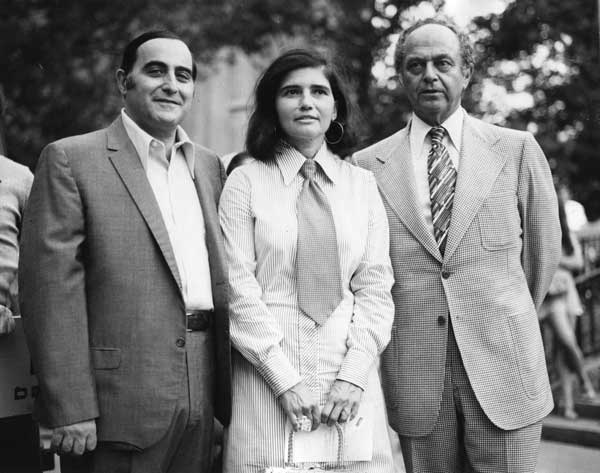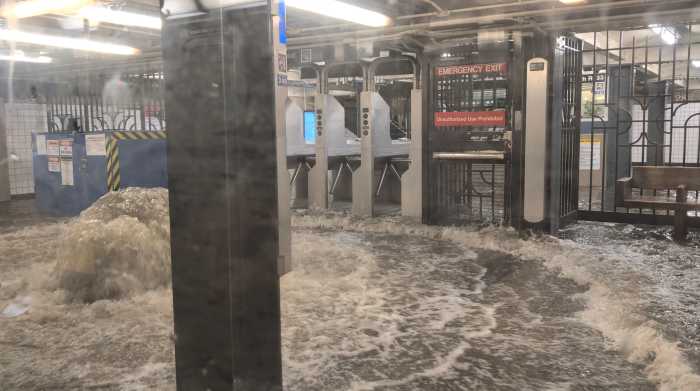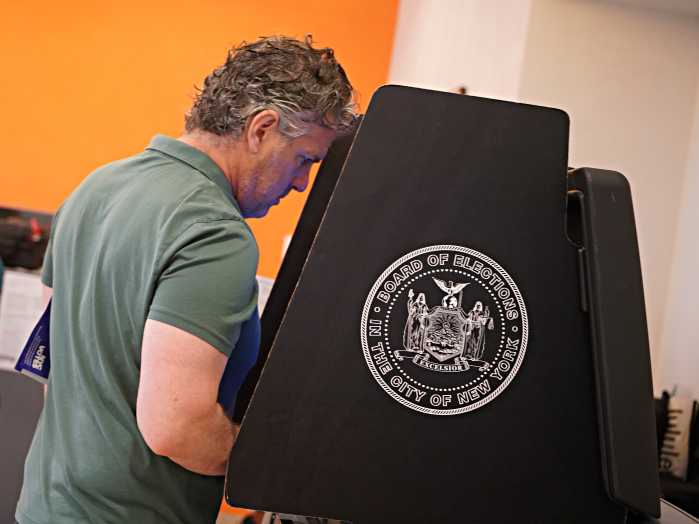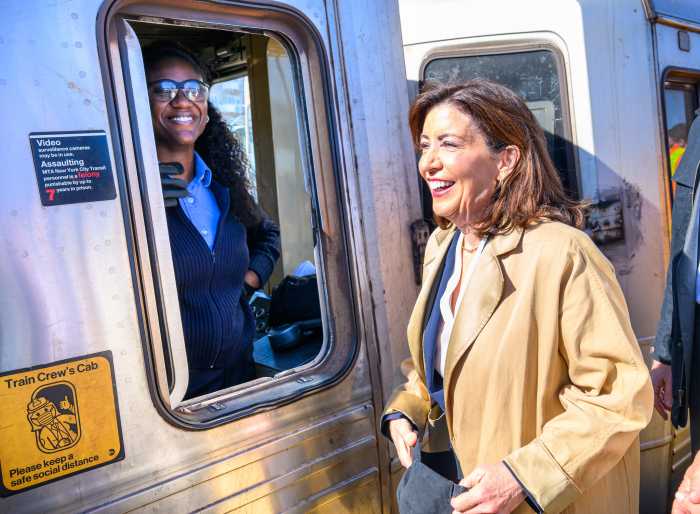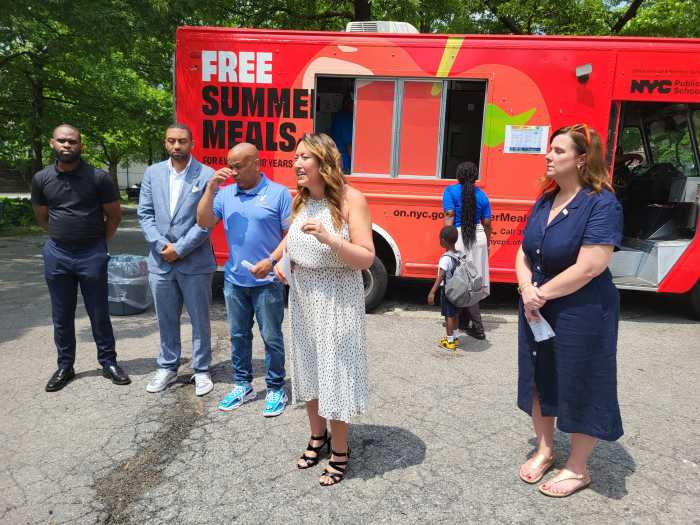Talking Point
- Carol Greitzer, a city councilmember, in the 1970s, flanked by Tony Dapolito, Community Board 2 chairperson, left, and Edgar Tafel, the architect of the First Presbyterian Church House.
BY CAROL GREITZER | Villagers should feel absolutely no reticence in asserting their opposition to New York University’s monstrous, grandiose 2031 plan. In view of the past shady actions of the old Board of Estimate, the community has a strong moral claim to demanding that current city officials take steps to right these wrongs — or at the very least, stop the former policy of opposing the public good.
We cannot allow this infill infamy to take place. The obvious solution is for Community Board 2 to support the Community Board 1 proposal that N.Y.U. expand into Lower Manhattan — a move that would benefit both communities.
I wrote the following talking point, “Greitzer’s View on Gym: Is N.Y.U. Playing Fair?” which ran in The Villager’s April 17, 1975, issue. At that time, C.B. 2 was about to deliberate on the issue of “the proposed N.Y.U. sports complex,” i.e. the future Coles gym.
*****
Currently the chief remaining controversy over the Washington Square Southeast Title I project involves the southeasternmost part — at Mercer and Houston Sts. — where N.Y.U. proposes to build a gymnasium.
Originally, N.Y.U. controlled only the northernmost section, where the library now stands. But in 1960 Tishman-Wolfe, developer of Washington Square Village, decided it wanted out, and negotiated for N.Y.U. to take over not only that project, but also the undeveloped three square blocks to the south.
When the deal became public, the community exploded. Among those speaking out against the N.Y.U. takeover were the local congressman, assemblyman and presidents of both the Greenwich Village Association and the Village Independent Democrats. The congressman was John Lindsay; the assemblyman, Bill Passannante; the president of G.V.A., Tony Dapolito, and the president of V.I.D. — the writer of this history.
Several people pointed out that under the Title I Slum Clearance Law, when a sponsor defaulted, the site was to revert back to the city for subsequent public bidding as happened with the Amsterdam Houses uptown. But the city seemed eager to expedite the N.Y.U. purchase. At this point, the university’s own building efforts were confined to razing a fine 17-story apartment building, despite the serious housing shortage. It would be a decade before the library would be built on that site. (N.Y.U. also demolished some nearby tennis courts that had been used by its own people and Villagers. The university apparently was not so concerned about recreational needs in those days!)
Because Washington Square Village apartments were renting for far more than the middle-income levels the community had been led to expect, Villagers demanded true moderate-priced housing for the vacant southern parcel. Still determined to accommodate N.Y.U., the city realized it had to make some concessions.
A compromise solution involved housing for N.Y.U. staff plus a middle-income cooperative for the public. In addition, N.Y.U. was to create an experimental elementary school open to Village youngsters. Still wanting more housing, the community felt this was the best it could get. Put in historical context, this was 1960 and the Village was less sophisticated about how to fight City Hall.
Within a few years, N.Y.U. began making noises about replacing the school with some sort of athletic facility and a plan was revealed recently. When confronted with the theory that they could not revise the provisions of the 9/15/60 Board of Estimate resolution which called for the experimental school, N.Y.U. cited a Board of Estimate resolution of 12/20/62 and an agreement entered into between the city and the university on 1/15/63 as authorization for substituting a gymnasium.
But this 1962 resolution continues to allude to the experimental school. The mayor was authorized to execute an agreement in accordance with the substance of the resolution, providing the agreement was “approved as to form” by the Corporation Counsel. The actual agreement, however, made what seemed to be a substantive change by stating “such land use may include appurtenant recreational, educational (including but not limited to a private elementary school), social and service facilities.” [A “private school” meant a free-tuition, neighborhood, experimental school operated by N.Y.U.]
Such a substantive change was really not legal, and it would be interesting to discover how the language crept into the January 1963 agreement signed by Deputy Mayor Edward F. Cavanagh. Was this phrase some clever maneuvering by N.Y.U., or perhaps a plot to circumvent a public hearing? We may never know.
We do know that this 1963 agreement was not revealed to the public till a few months ago and was never the subject of a public hearing. From both a legal and moral standpoint, since the community had been party to the original agreement, the community would clearly have to be consulted as to any subsequent change. Nor has N.Y.U. any right to act unilaterally in determining the future of this property, for back in 1960 the community would have taken legal action against the N.Y.U. takeover had the city not sweetened the pot with the school.
Without this essential ingredient the community would not have withdrawn its opposition to the N.Y.U. deal.
I want to make it clear that no one today wants an elementary school. But when N.Y.U. decided it no longer wanted to build a school, they were legally in default and the matter should have been brought up once again for public bidding. In fact, they were doubly in default because they were supposed to have completed the building within three years. However, as was shown before, the city was reluctant to declare a default on this project.
Because of zoning considerations which transferred additional bulk to the adjacent residential buildings, only a low-rise structure is now possible on this site, thus limiting the choices available. It may be that a recreational facility is now an appropriate solution, but if it is to be built at all, it must be done with the full consultation of the community, and it must be a shared facility. We all sympathize with the needs of N.Y.U. students for recreational facilities, but the residents of Greenwich Village also have serious recreational needs. We hope that a solution can be found that will be satisfactory to all.



